#and obviously in another 50-70 years the others start to show up
Text
I like to think Sasha and Marco embraced happily in the place all cadets and scouts go to after dying.
I like to think Sasha giggled and Marco smiled warmly before falling on his ass after Sasha tried to hug him too aggressively.
I like to think they sat down, had some of the endless meat and seafood that’s there whenever they may want it, and talked for hours.
I like to think Sasha tells Marco all about Jean, starting from the recovery after Trost to the airship, because she knows that’s what Marco is burning to ask about.
She tells Marco about Jean’s promotion to Commanding Officer, and he smiles so widely that Sasha’s own face hurts in response.
Then she tells him all about Connie, and Marco’s brow creases when he hears about Connie’s mother, but Sasha tells him how much stronger Connie is. How much more resilience they all have now. She tells him they’re working on a plan to change his mother back, and Marco is happy for him.
Then, she tells him all about her. She tells him how much of a pain in the ass the new uniform is, and how she loved the sea as much as Armin, because she now knows what lobster tastes like, and it’s even better than boar.
Sasha tells Marco all about their scary-but-caring-in-his-own-way captain, and about Ymir’s letter to Historia that finally confirmed what they all knew. She tells him about Reiner, Bertholdt, and Annie, and Marco tells her that he knows.
Sasha tells him Jean had suspected that Annie had something to do with his death, but they could never follow it up. She answers a lot of questions Marco has about them, where they’re from, what their goals were.
It gets a little heavy after that. So, Sasha makes him guess how tall everyone grew, and she actually stops eating enough to laugh when she sees how pink his face gets when he finds out how tall Jean got.
Marco tells her all about what the ‘afterlife’ is like. They don’t have to wait very long for Hange to show up, and they’re welcomed by the rest of the ex-scouts with open arms.
#and obviously in another 50-70 years the others start to show up#and it’s good#it’s happy#they’re happy#attack on titan#shingeki no kyojin#marco bodt#sasha braus#jean kirschtein#conny springer#levi ackerman#or if you wanna be funky:#marco bott#sasha blouse#jean kirstein#connie springer#jeanmarco#yumihisu#headcanons#aot drabbles#my drabbles#tw character death#discussions of the afterlife
63 notes
·
View notes
Note
recs for a beginner in greek? my interest is spurred via ancient greek, but i'm sure there are tons of tv shows and films that i'm missing out on
Do you mean Greek course recs? Or media recs? Couldn't tell.
If this is about courses, right now Duolingo is the one I would recommend the most for beginning up to reaching a low intermediate level.
Tons would be... an overstatement haha I do have some good recs though. You can watch all content in ERTFLIX, the ott platform of the Greek state TV channels, which is entirely for free and available worldwide. The TV series I personally recommend there is Καρτ Ποστάλ (Card Postal), it is gorgeous, introspective, philosophical. Then there is another famous show there, Κάνε ότι κοιμάσαι (Pretend you are asleep), which is crime / mystery / thriller, but I haven't watched it. A lot of people also love Τα καλύτερα μας χρόνια (Our best years), which is a family / period show set in the 60s-70s. I haven't watched this one either. Another personal rec would be Αγάπη παράνομη (Unlawful love), which is based on an old novel, but it gets very dark in a realistic way, so that's something you should know. Other than that, ERTFLIX also has foreign content with Greek subtitles, with which you could practice. And it has great Greek documentaries.
You could watch Maestro in Blue on Netflix. Season 2 will be out this spring! Beautiful show, fantastic performances, great music.
There's also a man, George, who has been making English subtitles for various classic Greek series, comedies and dramas, including top tier Είσαι το ταίρι μου (You are my soulmate), a hugely clever and unusual rom-com, Στο παρά πέντε (In the nick of time), a crime and mystery comedy which is considered one of the two best Greek comedies ever and must have the thickest plot I have seen in a comedy (very popular show with the Greek tumblrs here) and OF COURSE ΤΟ ΝΗΣΙ ΑΚΑ THE ISLAND, a drama which is the best Greek series to date and for which I have entirely normal reactions. Here I link the post I had made about George's platform.
If you don't care to have subtitles at all you can find these shows and many others in DailyMotion and especially the website greek-movies.com. (this needs vpn, you know). This one has it all. Literally all, including the classics, classic Greek cinema of the 50s-60s-70s was by far the best era.
I am currently watching Η Μάγισσα (The Witch). There are some talks that it could go to some international streaming platform after it ends but you can watch it in the aforementioned website anyway without subtitles. I love this show, it's semi-daily, so this season will have 70 episodes, and obviously it comes with the limitations of daily shows, but as semi-daily shows go, it is bloody fantastic, I am obsessed right now.
YouTube also has a lot of old Greek series. The first thing you should do after starting any Modern Greek course is to start watching Κωνσταντίνου και Ελένης (Constantine and Helen's) on youtube, the best Greek comedy, or maybe the best comedy in the universe, with only slight exaggeration 😜😇 The aforementioned Είσαι το ταίρι μου, is also available on youtube with George's subtitles.
Some additional links of older posts to check:
10 best animated movies to watch in Greek (foreign ones with great Greek dubs)
My favourite Greek movies
Check my #greek tv series and #greek movies tags for more.
#greece#greek language#language learning#duolingo#greek tv series#greek tv shows#greek shows#greek movies#anon#ask
27 notes
·
View notes
Note
https://www.tumblr.com/mistressemmedi/740063884004802560/anyways-the-funny-thing-about-the-dakar-is-that?source=share
Can you explain the full story, please?
Absolutely but we need to start from the beginning. Back in the 70s this French madlad, Thierry Sabine, got lost in the Sahara while competing in another rally raid. He made it back to civilization and thought to himself "This was a great experience, we should make it a regular thing! Rally raids in the desert!" so, in 1977, Thierry organized a large scale rally that would cross the whole Sahara - starting point would be Paris and the end would be the capital of Senegal, Dakar.
I guess Thierry was not the only madlad around because 180+ other drivers/riders etc decided to join in on the fun. Popularity rose the following few years thanks to big name entries such as Jacky Ickx. The rally was very much an adventure: you got a general map indicating stops you should make on your way to Senegal and... That was kind of it. No teams, no real backup. People showed up in modified everyday cars, someone even raced in a modified Rolls Royce lmao
So by 1982. the rally was kinda known but it wasn't the scale it was today. Enter our main character: Mark Thatcher, absolute weapon of a man (honestly, look him up... Man does not sound like he's the sharpest tool in the shed lmao) and unfortunate son of one Margaret Thatcher (prime minister of England at the time). He decides to enter the rally with his lil Peugeot 504 with no real prior experience besides racing Le Mans twice (which... uh, very different from a rally in the desert). So he starts off with his co-driver and mechanic in tow and gets lost in the desert. It happens, right? People usually turn up after a day or so. Well, after 3 days he's officially declared missing and mommy dearest is informed. Obviously the son of the Prime Minister being lost somewhere in the Sahara is quite a big deal, so the news was all over that, and Old Maggie decided to flex some of that British muscle - a rescue is launched, involving three separate countries who sent out military aircrafts to search for this moron in the desert, as well as Algeria dispatching its soldiers to find the guy.
After a few days, Mark is found about only 50 kms away from the main route of the race 💀 which caused quite a bit of embarrassment on an international scale to his mom.
Anyways, bad publicity is still publicity after all, and by the year after there were 450+ entries to the rally which included big name manufacturers such as Porsche etc. and it evolved in the crazy 2 week rally that we know today!
Bonus - Quotes from Mark Thatcher about the whole ordeal:
Before competing he said:
"I've now raced in Le Mans and other things – this rally is no problem."
In 2004, Thatcher wrote about his experience:
"I did absolutely no preparation. Nothing."
"We must have hit something. ... We stopped. The others stopped too, took a note of where we were and went on. But the silly bastards – instead of telling everyone we were 25 miles east when they finished the section, they told them we were 25 miles west."
"So The Boss (the prime minister) does entirely the right thing, picks up the phone to the ambassador in Algiers and says, "Can you find out what is going on?" The ambassador then rings the prefect of the region who says there are four people missing and that I am one of them."
18 notes
·
View notes
Note
I loved that in your Austin!Elvis NSFW alphabet you did 50s, 60s and 70s separately. Do you think you could do something like that when it comes to jealousy? Like what kind of jealous man was he throughout the years as he got more famous? Thank you!
oooh yes i love this
50s Elvis is fairly jealous. He wants to have you to himself, but he doesn't yet have that need for other people to know that you're taken. Obviously, he'll beat some ass if any man tries to flirt with you, but he hasn't realized that he can claim you publicly yet. He just prefers to hold hands and gift you some of his clothes and/or jewelry to wear. But like I said, if any other man so much as looks at you the wrong way, he's gonna kick some serious ass. He's not one to shy away from a fight, especially if it's your honor at stake.
60s Elvis is already more jealous but at the same time less jealous. Earlier 60s Elvis doesn't have the confidence to be jealous. He isn't quite sure who he is or what he's about, so he just doesn't feel worthy enough of being jealous. He wonders if maybe you deserve someone better. Post 68 Comeback, he grows more jealous by the minute. At this point, he starts to remember that he's sexy and talented. He knows what he can do to women and he takes that confidence seriously. He knows that he deserves someone as perfect as you, and he'll make sure to defend that relationship for anything. He's less likely to fight a bitch and more likely to just wreck them with the truth. Like that one anon sent in that TikTok where the kid was asking if the girl wanted to fuck and the dad straight said "she doesn't want you. she wants daddy" 🥵 that's 60s Elvis.
70s Elvis is sooo fucking jealous. He has the utmost confidence at this point. He knows his power and how iconic he is and he also now wants everyone else to know that he owns you. He sees you as the most perfect being on the planet and wants to be able to publicly claim you and show everyone else just how much you belong to him. We've discussed SDE with the collar and the rings, but even if he's not a sugar daddy, I still see Elvis wanting you to wear a TCB ring or one of his scarves or something like that to show the entire world that you're his and his alone. If you accidentally flirt (or another man flirts with you) with someone other than him, you'll recognize your mistake in the bedroom later. He will fuck you up (literally) so hard. He's spanking, choking, biting, maybe even dishing out a little light slap to the face. Bondage, edging, etc.
tl;dr: you're gonna know just how badly you fucked up
#answered#milas thirsty thursday#dirty deeds#milasthings#milaselviscontent#milasheadcanons#milaselvisheadcanons
32 notes
·
View notes
Text
Andy Grey and the Abbott Mansion Murderer (Part 1)
I had always prided myself on being analytical and cool in the face of fear and danger, but when I was confronted with the real possibility of being trapped in a house with a murderer, that cool facade flew out the window.
“I only write about murder! I don't want to be part of a real murder! I’m too young to die!”
“Diane, you are 70 years old, I’m pretty sure you're past your expiration date”
“What do you know about expiration dates Carl? Your stories expired on the shelves years ago, it's a wonder you were even invited to this convention,”
“I’m pretty sure the only reason people were invited to this was so the coordinator could slowly pick us all off one by one,” I pipe up frantically, in hopes to get the others to shut the fuck up so I could think.
After being a murder mystery novelist for the past 15 years I was thrilled to be invited to this convention, with the chance to meet some of the best writers from the past 50 years, but a couple of things kind of ruined that.
The hurricane that is cutting off all cell service.
The corpses that began showing up.
There had originally been 10 of us at the convention, now only 5 of us were left, potentially 6, but there is a chance that if the sixth is alive, they aren’t on our side.

“And what would you know, I hadn’t even heard of you before coming to this convention, what could you possibly know about murder and the motives of a murderer,” mutters Carl, who I was quickly beginning to despise as the night went on.
“Just because you haven’t heard of me doesn't mean shit,'' I spit at him. “There are 4 bodies and 1 person missing right now, I don't think you should be focusing on how little recognition I've had over the years, maybe more on finding out who is killing us and why they want to do this! In case you haven't noticed, we are trapped here with no cell service until the hurricane calms down which isn’t likely to happen for at least another 12 hours,” I continue. Carl looks ashamed at his actions.
Diane quickly steps in and adds “Yes, but don’t we already know who’s doing it? It's obviously the person that went missing - their body is the only one that hasn't turned up yet, so they are the most likely suspect,”
“Not necessarily,” I reason with her. “Isn’t it the first rule of a murder mystery to throw off the detectives, to create a red herring?”The other four in the room murmur their agreement
“I suppose you're right,” replies Emerson in a quiet voice. She is the only one close to my age, being the youngest here at 22 and me being 28.
Both Emerson and I started writing out murder mystery stories at a young age, catching the attention of publishers before we each reached 18. Before that I had only had recognition on small blog posts as a writer, until I hit the big tims. After my first novel that sold however I was struggling to keep up with sales and demand for new books. This struggle to keep up with popular demand over the years is what made me skepctical of my invitation to the convention at Abbott House.

Many rumours circulated for years, inspiring many of the famous mystery writers invited to the convention, especially Diane.
So far this evening 4 bodies have been found, all displayed the same way as the Abbot family was; throats slashed and a rose stuck in the open stab wound through their hearts. The first victim was found after everyone heard a shrill scream around 11pm, at which time most of us were in our assigned guest rooms. The victims tonight were Christina Stewart, a 45 year old writer who had been topping sales charts for the past 20 years. Colin Dawson, a 37 year old writer from the south who was well known for his detective series inspired by Agatha Christie’s Poirot novels, Luna Harkin, 53 years old from Spain, who specialized in amateur detective novels, and lastly the body of Chadwick Bradbury was found, 68 year old writer who was famous in his prime for his gruesome stories based in the 50’s about women being slain for their organs.
All found dead within an hour, and nobody knows who did it.
#jbookreviews#who did it#cozy mystery#cozymysteries#whodunnit#Andy Grey and the Abbott Mansion Murderer#j short stories#j rants#I wrote this for an assignment please don’t judge me#murder mystery#short story#short fiction#original story#original short story
5 notes
·
View notes
Text
How much should it cost to hire an app developer?
U.S. dollars in 2019-2027 and complete income is supposed to show a yearly development rate (CAGR 2022-2027) of 11.28%. Isn't it awestruck? The app store report by business of apps reveals that there are millions of apps on the app store. Obviously, a couple of out of 1,000,000 get by, as they will generally stand apart among the other applications. While fostering a mobile application, the principal question that springs up in the psyche of any business person and entrepreneur is the cost of developing a mobile application. It’s crucial to focus on estimating the Elearning App Development Cost In India which includes, the cost to hire an app developer, UI UX designer, project manager, and launch. With the goal that you can consistently disperse the financial plan for hiring the app developer, promoting, marking, and group obtaining.
We know it's critical to zero in on fostering an intelligent and natural Mobile application to stand apart from the market and lift income. The average cost of hiring an app developer starts from $50 and can go up to $110.
Does this infer that a $110 developer is best for you? Or should we perhaps go with hiring in between, that is, $70 per hour.
There’s no straight answer to this question. It entirely depends on the company’s requirements and budget. Prior to hiring vetted remote developers, it is crucial to have relevant market data for better comprehension.
Also Read More: best mobile app development companies in bangalore
What sum does it cost to make an application
There are lots of elements that influence the expense of fostering an application functionality and purpose, integration points, mobile platforms, types of features and technology, integration of visual objects, maintenance plan, and many more.
Nonetheless, by and large, the expense of application improvement for straightforward applications begins at $40,000 and can reach out up to $70,000 or more. For developing a medium-complex app, it starts from $70,000 and can extend up to $1,3000; for a complex app, it starts from $1,3000 and can go beyond.
Factors influencing the cost of hiring an application designer?
Qualifications
The cost can be affected by a developer's qualifications and abilities. It’s quite obvious to say that the higher the qualifications and skills, the higher the cost. On the off chance that you're hoping to enlist a full-stack designer, the odds are higher that the expense may be impacted. Also, if you have a tight budget, you might need to hire accordingly.
Experience
Hiring an experienced developer will always result in a higher hourly rate than hiring novice or inexperienced developers. It will ultimately essentially affect the expense of recruiting.
Geographical Location
Among different variables impacting the expense of recruiting, area is one of the great elements. Different geographical locations have different standards of living and labor market saturation.
For example, employing an application designer with 5 to 8 years of involvement with the USA, Europe, UK is definitely more costly than in different nations like India, China, Sri Lanka, and others.
Elevated requirements of living, less accessibility of assets, and a few different reasons influence the expense of employing designers in the USA.
Technology
Another critical variable that influences the expense is the technology stack. The IT market is immense and offers different programming dialects and structures, making it more costly.
The assessed cost of hiring a freelancer, hiring agency, and staff augmentation company
Freelancer
If you’re tight on budget and are looking for affordable options to hire app developers, then hiring a freelancer is the best option.
The expense of recruiting independent engineers in India begins at $15 and can reach out up to $30.
Hiring or Recruiting agency
Hiring a recruiting agency is the safe bet when it comes to saving resources and time. When hiring a recruiting agency, you don’t have to do any leg work so you can easily devote time to other important tasks.
The enrollment organization will do all that from recruiting the best competitors from the pool of groups to participating in application development.
Also Read More: Mobile Game development companies in Bangalore
Staff augmentation company
This model works well when you need services such as hiring and technical assistance. On the off chance that you have a fair financial plan, you can without much of a stretch recruit a staff expansion organization to facilitate your work and give bother free administrations.
When you delegate the administrations to a solid staff augmentation company, you won't need to place in any mind or accomplish any leg function as you will get both technical assistance and a successful quest for developers.

0 notes
Note
I’m so jealous. I wish I could sit and read for several hours straight. Sometimes I get too antsy to do that, and other times the book I’m reading doesn’t hold my attention. I’ve read some books I’ve absolutely hated, and my coworkers will always say “you could just stop reading it and read something else.” I wish I could, but once I start a book I have to finish it.
Last year I read 49.5 books. I wanted to finish Hearts in Atlantis before the year ended, but the part I was reading didn’t hold my attention. I didn’t want to read it more than I had to. I love ended 2021 exactly at the halfway point of it which I think is kinda cool. My goal for this year is 50.5 (so one extra full book than last year) and for 2023 I’d like to read 52 books. Right now I’m not sure how many books I’m at. I keep track, but I can’t get up and check because my cat is laying on me.
I’m jealous of people that can read multiple books at a time. I’m thinking of starting a Stephen King short story collection while I’m reading a book. I want to read everything he’s written but short stories seem to drag for me. Most of the time. Some are really easy to get through. Most of the time when I read short stories I feel like I’m starting a book in the middle and trying to figure out what’s going on. I feel like that’s because I go into a short story not really knowing the plot. Idk.
I’m on a subdivision of tik tok called booktok. It’s not good for my bank account because I see more books I’m interested in. Sometimes people will list all the books they read during the month and they have like 10 books. I wanna know how. Maybe they read for several hours straight or maybe they read multiple at the same time. I’m not sure.
🦇
also I just finished reading Sharp Objects. I could’ve read that in one or close to one sitting but I was really tired this past week. What books did you read?
also the cat left. This year I’ve read 24 books.
ALSO I loved the one shot. I love how horny they are for each other. I’m so glad they’ve finally fucked while sparring. Chefs kiss!
I'm the same way!! If I don't like a book I still have to finish it. I try to be really careful when picking books for that reason 😂 The best way to figure it out is to look up 3 star reviews for the book. I've found that those are the most honest.
That's a lot of books!! I haven't read much lately while writing motn because it took over my entire life 🥵 You're doing better than me because I've only read 22 books so far. My goal is 70 this year but I think it's too ambitious 😂 Usually I read between 50-60 per year. In college it was only like....30 a year. If that.
I'm jealous of people who can read multiple books at one time. The only way I think that'd be possible for me would be if I switched between a physical or ebook and an audiobook. Since it'd be a difference between reading and listening. However, I don't really do audiobooks 😂 And I get too confused switching between books.
I'm on bookstagram but all of the booktoks make it there. It's also not good for my bank account 🥵 
Was Sharp Objects good? I really enjoyed the HBO show!
I recently finished an early copy of a book called A Lady's Guide to Fortune-Hunting (a historical romance), a romance called In Five Years, and another the Love Hypothesis. Currently I'm reading another romance called Book Lovers and it's the funniest book I've ever read. I've been doing a lot of romance since motn was heavy, and it always helps me get out of a reading slump because I can read them quickly.
And thanks re: the oneshot!! When I wrote their very first sparring scene way back when, I had the idea. So obviously I had to do it 😂
0 notes
Text
How To Tell Victorian Clothing Apart By Decades
First and foremost, Karolina Żebrowska made a video about this quite some time ago explaing everything in detail, but I just wanted to make my own little checklist and mention some things that I’ve noticed for myself. Of course, this list won’t be foolproof as I’m only going to talk about the most popular styles at the time and people technically could have made a regency gown in 1900, but... that’s not the point. For the sake of being able to show everything with pictures, I’m going to leave the Regency period out as I’ve already made a separate post about it.
The Victorian era is commonly packed into the visual of a brown bustle dress and/or the typical wide dresses of the Civil War, but the Victorian era actually spans over 64 years and many, many different styles.
Queen Victoria was crowned in 1837, so let’s start in the 1830s.
The 30s were wild, and that’s one word to describe it, but that mostly goes for the first half of the decade. Huge sleeves and full skirts were the thing, often in patterns inspired by wallpaper. That’s right - stripes, florals and anything that stood out was the hit. The off-the-shoulder look is just as important though, that’s what creates the round shoulder shape, together with the puff sleeves. The waistline sat a little higher than the natural waistline and was usually adorned with a belt. In the second half of the decade the sleeves started to "travel downwards", as in they started smocking or gathering the top part of the sleeve and just leave the pouf at the bottom.
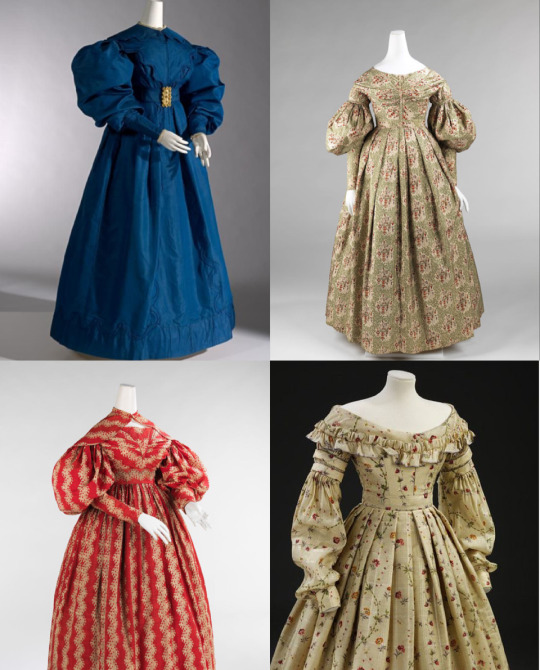
The 40s left the puff sleeves and bright patterns behind, leaving high necklines, tighter sleeves and lowered the waistline to its natural position. Something very popular was the gathered front of a bodice and that trend even lasted into the early 50s. Skirts grew a little wider, requiring more support from layers upon layers of petticoats.

With the 50s here, ruffles came into fashion. If you see a wide, ruffled skirt, it’s probably from the 1850s. Some bodices extended over the hips now and almost looked like coats. Another important aspect: the pagoda sleeve. And obviously it’s important to note that the crinoline was finally patented in 1856. No more layers upon layers of corded petticoats! But this meant that dresses could be even wider than before. However, keep in mind that in the 50s, the crinoline had a round shape whereas in the 60s it started to become oval and extended further towards the back.

With the 60s, ruffles went out of fashion and synthetic dyes were invented, this meant brighter colors for a wider population! Actually, synthetic dyes were already invented in 56, but just like everything it took a while to make all the colors and really catch on so I’m counting it towards the 60s, because that’s when brightly colored dresses really took off. I find that especially evening dresses look very similar to 50s evening dresses so for me the best way to tell them apart is to look at the shape of the crinoline. Not to mention that a lot of people certainly continued to wear or slighly altered their 50s dresses but with a new crinoline.

Now we’re in the bustle era - the shape of the crinoline became slimmer but extended further towards the back, creating the bustle. I still find myself struggling telling mid 70s styles apart from the 80s, but there are some things I look at.
Firstly, the shape of the bustle. Early 70s style bustles are still pretty wide compared to the later silhouettes. Generally, you can say that in the 1870s, the profile of the bustle has a more gentle curve, the curve is not as steep. Also, a lot of 70s day dresses have trains. Many people actually started recycling old 18th century gowns into 1870s dresses so you can see a lot of inspiration and similarity in the shapes and how the dress is put together. The collars often mimick those of 18th century gowns and the back is draped like it was on a Robe à la Polonaise. Towards the very end of the 70s, bustles went out of style and women wore their dresses without a bustle.

Now on to the 1880s. Like I mentioned, the style was very similar but the bustle came back into fashion and became steeper. The necklines on day dresses were high and the collars weren’t square anymore. The draping of the overskirt still stuck, but the skirts became overall a little less wide. Very popular in the mid 1880s was draping the overskirt asymmetrically. That is the best giveaway if you’re unsure. Trains on day dresses still existed but weren’t as common as in the 70s. And once again, towards the very end of the decade the bustle went out of fashion, this time for good.
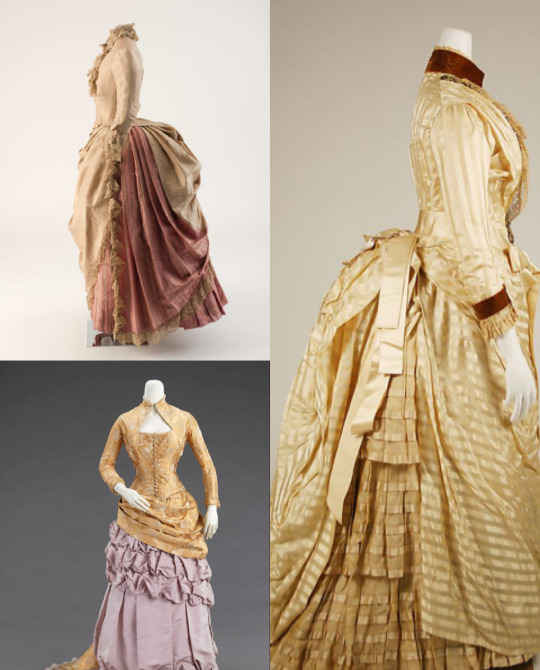
The 90s - certainly my favorite decade in the 19th century. Big sleeves were back! But no off-shoulder day dresses and the waistline was at its natural position. Pretty much all skirts were now straight in the front and gathered in the back - a very popular look. The size of the sleeves and the width of the dress reached its peak in 1895 and after that it all decreased in size again until the puff sleeve went out of fashion in 1898-99. Bodices had a slightly looser fit than in the decade before but were still tight-ish.

Now, the Victorian era only lasted up until 1901, but I’ve decided to add the 1900s to this list just because I really like that decade as well and think the clothes are really pretty.
So, in the 1900s the silhouette changed once again. Now, loose lace blouses were all the rage and the so-called pigeon breast silhouette was created with the help of an s-bend corset and a lot of stategical padding, a frilly corset cover and a loose gathered bodice. At the waist, you’d usually find a silk belt called a sash that matched the dress. The straight front skirts stayed but changed their shape slightly to be bell-shaped and flare out at the bottom. A lot of lace was used for gowns as well as frills and dainty details. But on the other side, a working woman would usually just wear a light colored blouse with a usually dark skirt and wear a belt to tie the outfit together.

So this was my way to tell the decades apart! I specifically love 19th century fashion because every decade is so different from the one before and it’s so fascinating how quickly styles changed back then.
#victorian#fashion#fashion history#historical fashion#victorian fashion#victorian dress#historical dress#edwardian#edwardian fashion#victorian clothing
686 notes
·
View notes
Text
History of Chinese standing collars (part 3: post republican era)
Quick recap: I was debating with myself whether “Mandarin collar” should be a thing because standing collars throughout Chinese history looked different. I went through the Ming and Qing dynasties in part 1 and the republican era in part 2, now I’ll look at what comes after that. I numbered the styles in parts 1 and 2 but they’re only guidelines so you don’t have to remember anything.
So in this post we’ve kind of reached the end of the era where fashion consisted of a single silhouette in any given year and all hell ran loose. I’m having a lot of difficulties classifying things as Chinese or Western because the distinction is really blurred, and I also ran into problems explaining why certain historical European things looked so similar to Chinese ones so there will also be a lot of confusion.
1950s & 60s Chinese application
Summary of 1950s fashion, mainland and others.
Because of the communist victory in the Civil War, fashion in the mainland was different to other (capitalist) areas populated by the Chinese diaspora such as Hong Kong, Macau, Taiwan etc.. Let’s look at capitalist area fashion first; I’ll be referring to Hong Kong because Hong Kong was the center of cheongsam making at the time.
Collars on 50s Hong Kong cheongsam grew taller on the basis of collar style 10 but retained the rounded, tapering edge, resulting in a v shape gap down the middle that weirdly recalls collar style 6 from part 1 and part 2. It’s basically completely identical to collar style 6 but stiffened and extremely form fitting. It’s usually closed with one pankou at the base but because of westernization, 50s cheongsam often had no visible pankou----everything is closed with snap buttons, zippers or hooks and eyes/bars. An important aspect of collars of 50s and 60s Hong Kong cheongsam is that they left out the binding around the neck. All cheongsam prior to this point were bound around the exterior edge, the side closure, the slits and the collar seam (on the bodice not the collar), 50s cheongsam collars purposefully neglected the binding at the collar seam for some reasons. This makes the collar look like it’s one continuous piece of fabric with the bodice, which it isn’t. A lot of modern representation of cheongsam or any Chinese inspired clothing (in video games, books and anime etc.) do this, even if the character is from before the 1950s. It REALLY bugs me. If you are an artist or writer and designing costumes for Chinese characters prior to the 50s, please include binding/trimmings on all three seams, it’s an easy way to bump up historical accuracy. With that said, completely plain collars without any binding or trim was actually the most common. Let’s call this collar style 13.
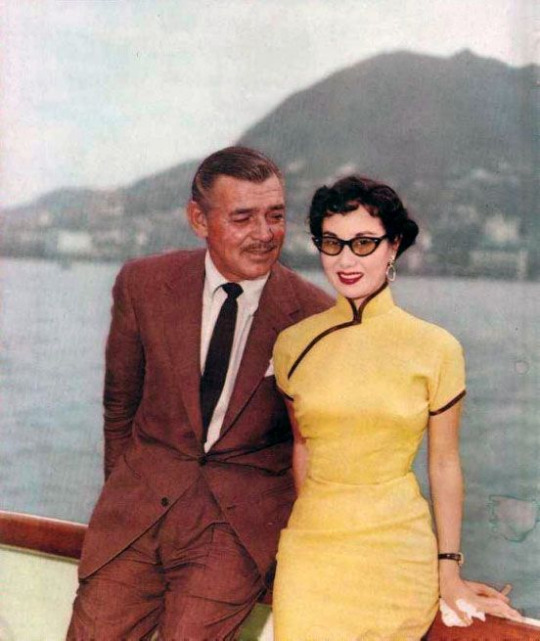
Source here
1954 photograph of Li Lihua and Clark Gable. Collar style 13 with stiffening and no collar seam binding. You can see how firm and neck hugging the collar is, contrary to a lot of modern cheongsam collars which are saggy and loose.
The popularity of collar style 13 continued into the 60s. When the cheongsam fell out of popularity, it ceased to exist as well.

Source here
60s cheongsam with collar style 13. I’m really not a fan of the nude/light lipstick trend of the 60s, like, as a person with no lip color definition it makes me look like a potato.
Now moving on to mainland collars. In the 1950s, cheongsam with the 40s collar style 12 were still occasionally seen, but the fashionable collar shape also became taller and was similar to the Hong Kong collar style 13. Interestingly, some 50s mainland cheongsam retained the binding around the collar seam, making them look more “traditional” in a sense. However, collars both with and without collar seam binding existed and it was just a matter of personal preference.
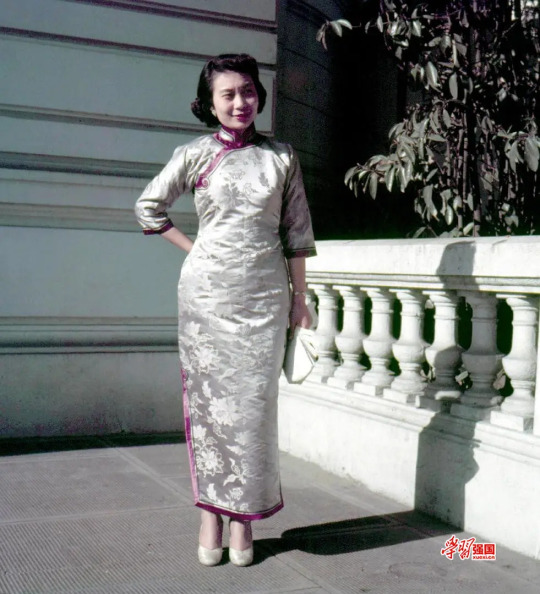
Source here
1950s photograph of a mainland lady in cheongsam. The collar is taller and closes with one button, much like Hong Kong collars of the era, but the neck binding is present.
Aoku robe collars from the 1940s onward mostly had the 40s style low collar, although in the 50s and 60s they rose in height very slightly.

Source here
1964 poster showing a girl in aoku, the robe has a low, rounded collar.
However, garments with a standing collar became worn a lot less frequently in the 50s and 60s in both mainland and non-mainland areas, since a lot of people adopted Western fashion.
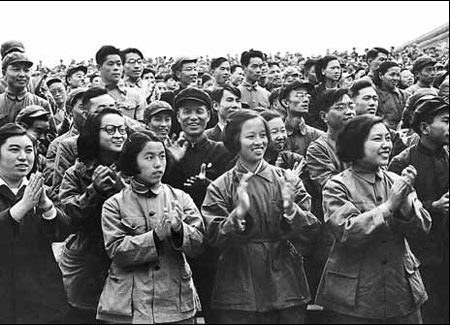
Source here
1950s photograph of a group of mainland people wearing jackets of Western construction. Some of them seem to be wearing informal military jackets, commonly known as “Mao suit” or “Zhongshan suit” nowadays, with folded collars.
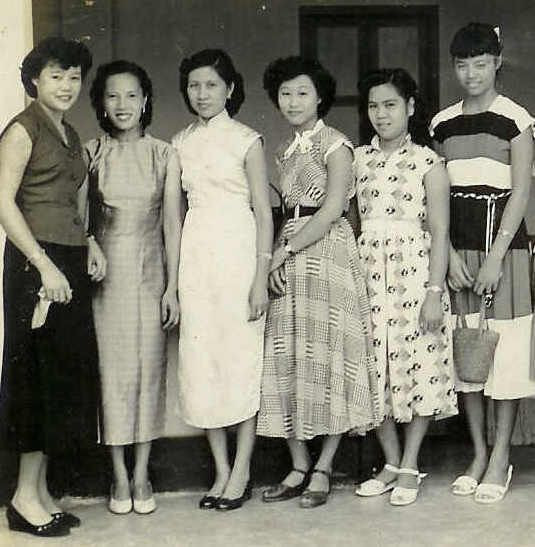
Source here
1950s photograph of some women in Malaysia, some in cheongsam and some in Western New Look dresses.
Western application
I think it’s also quite important to discuss how Chinese standing collars were perceived by Western designers, because the Western fashion industry does hold a lot more power globally and also reverse influenced Chinese collar designs in the post 1960s era. So, in the 1950s and 60s Western designers thought cheongsam was really cool and produced a lot of affordable sewing patterns for their versions of cheongsam. I think this is also because pre-1950s cheongsam didn’t use the Western construction method and patterns needed to be individually drafted so it was difficult to make mass produced sewing patterns. From all the sewing patterns I have seen personally, the super tall standing collar popular in Hong Kong was not really appreciated by Western designers at all?? Western cheongsam sewing patterns all had the very low 1940s style collar, combined with an hourglass silhouette New Look bodice and skirt, looking rather anachronistic. These collars also didn’t have binding/trim around the collar seam, in line with fashionable Hong Kong cheongsam of the day.

Source here
1950s Advance sewing pattern for cheongsam. The collar is low and has rectangular edges, something about a decade out of fashion in Hong Kong and Shanghai. No collar seam binding.
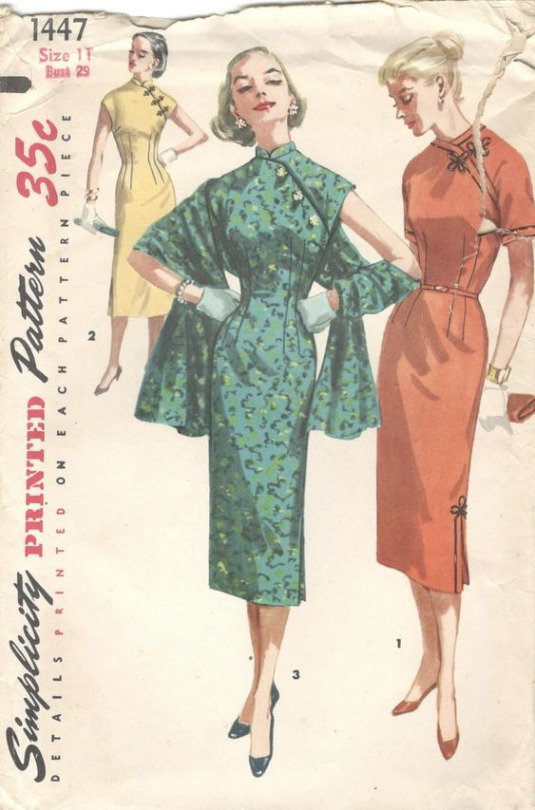
Source here
1950s Simplicity sewing pattern for cheongsam. Likewise with super low 1940s collars. Collarless cheongsam died in China in the mid 1920s, yet it lives on in the imagination of Western designers. By the way, the frog closures with a quatrefoil shape are not Chinese, I’m gonna write another post about this. I love the look in the middle it’s very glam.
1970s and later
The post 1960s era is what ultimately created the confusion around standing collars nowadays. Around this time Western and Chinese fashions started to merge and become one, and garments made completely in the historical Chinese method were more and more difficult to come by; Western construction techniques reigned supreme.
From the 70s onward, most “Chinese collars” had the 40s rounded edge shape but were either medium low or medium height. The lack of collar seam binding persisted into the current day, which is something I kind of lament because without this binding collars easily read as Renaissance doublet... (more on that later)
I usually avoid calling any standing collars from the 1970s onward Chinese/Mandarin because 1) standing collars were never a uniquely Chinese thing to begin with 2) since cheongsam was no longer fashionable among actual Chinese people, designers who made cheongsam pulled all kinds of shenanigans without any historical precedent whatsoever. Also, since clothes with structured/stiffened standing collars stopped being a staple in the average Western person’s wardrobe, white people started calling everything with the most remote hint of a standing collar Chinese to further stir the pot, emboldened by the cultural appropriation craze of the 60s and 70s. Ok that’s very loaded, but it’s true that in the 60s and 70s there was a lot of Western clothing designs that took inspiration from other cultures without permission. Westerners could totally design and wear Chinese style clothing given that the intention is respectful and they know about the garment in question, but a lot of times the accuracy of the designs leaves much to be desired. There was also a lot of Orientalist inspiration in the 10s and 20s but the borrowing back then wasn’t so... literal. When I look at so called cheongsam sewing patterns from the 70s onward, I sometimes seriously have trouble identifying if something is meant to be Chinese, Vietnamese, Japanese, Polynesian or any other region/culture...
I’ll just find pictures of Chinese inspired clothing from the 70s onward with a “Mandarin collar” label and point out their source of inspiration.
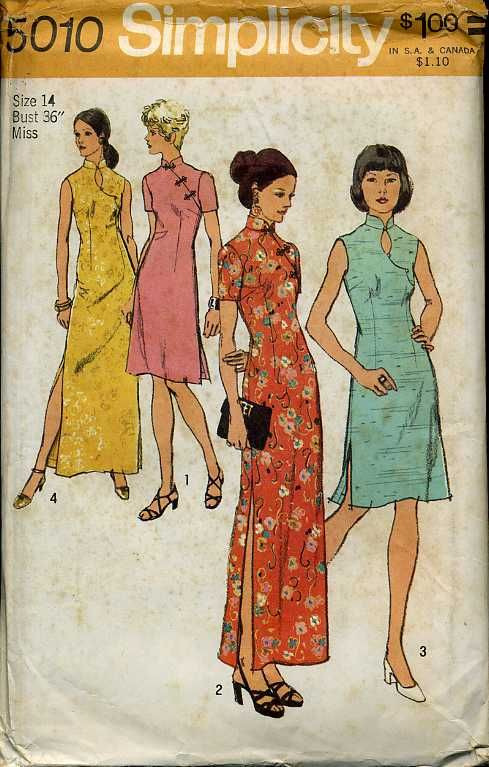
Source here
1972 Simplicity sewing pattern for cheongsam. It’s the same Western collar from the 50s and 60s just slightly taller. Oh and the closures used on the two designs in the middle are again likely not pankou. After the 60s, this neck design with a oval shape keyhole cutout became quite common and that persisted to the current day. Don’t know what the purpose of that was, just because you show 5 square centimeters more skin doesn’t mean your cheongsam is sexier?

Source here
The description of this 70s Simplicity pattern says “Mandarin collar” but the source of inspiration is obviously Japanese military/school uniforms, AGAIN. The collar’s height and rectangular edges, combined with the placement of buttons above the waist on the bodice, everything about this reads as Japanese. The frog closures on the left are once again European and not Chinese pankou (sheesh I really need to make this other post). The original designer probably meant for it to be Japanese but the seller mistakenly labelled it a Mandarin collar design.
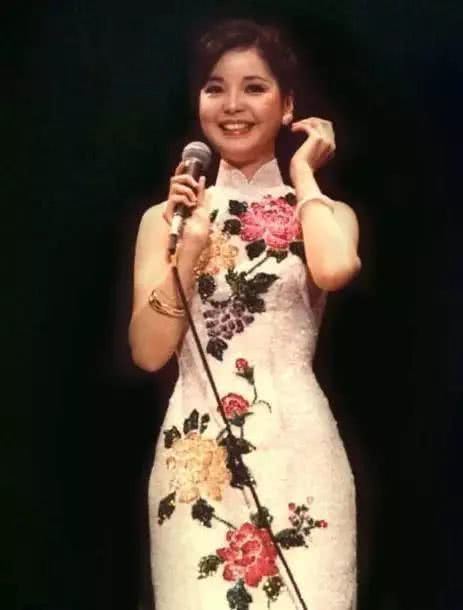
Source here
70s Teresa Teng (rest in power legend) in a theatrical cheongsam with a similar collar, either a stretched version of the 40s collar or a shrunk version of the 50s/60s one.
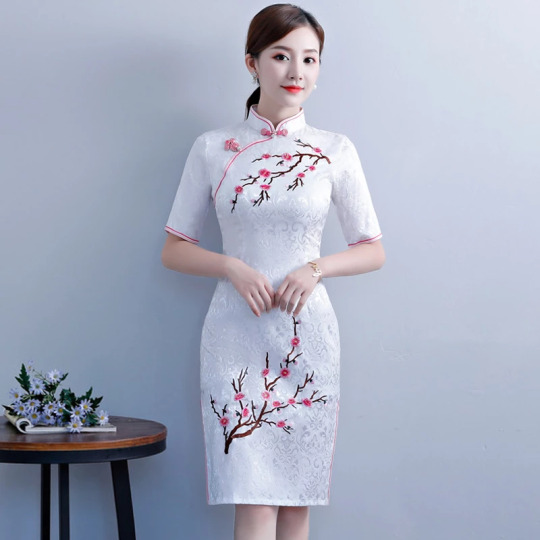
Source here
Google search result for “Mandarin collar dress”. Same Western low collar from the 70s. A new problem with modern mass produced cheongsam is that the collar oftentimes doesn’t fit the wearer and appears too baggy. Or maybe it’s not mass production, just that people nowadays are very unaccustomed to wearing tight fitting standing collars so they assume there needs to be some extra space? As someone who wears stiff standing collars on a regular basis I have to say it actually isn’t uncomfortable at all and elongates your neck a lot better. This is what most cheongsam collars nowadays look like, even the self proclaimed “traditional” ones, they literally originated from 1950s/60s Western sewing pattern companies’ interpretation of contemporary Chinese cheongsam collars.
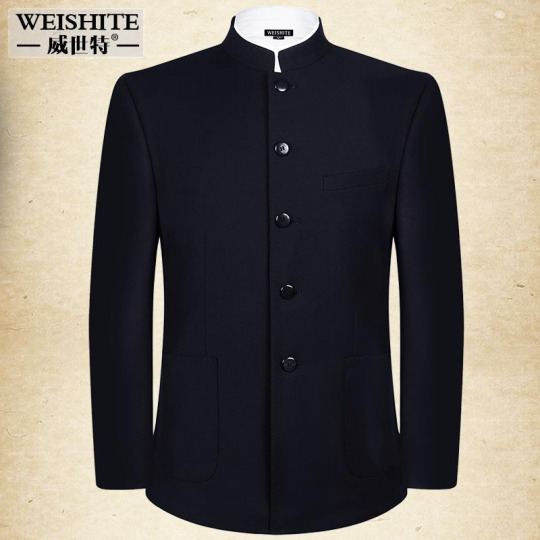
Source here
Baidu search result for “Mandarin collar suit”. This, is, literally, almost a replica Japanese uniform. The seller is also using the tag Zhongshan suit lmao (I’ve explained in my 1950s mainland post what a Zhongshan suit is not supposed to look like), delusion is not a fragrance I guess. Why is it so hard to let Japan be Japan and China be China??
Conclusion & afterthought
Another thing I need to mention is that standing collars are by no means unique to Chinese historical dress; they were also widely used in European historical fashion, long before standing collars became worn with uniforms of “Mandarins” or Chinese officials, which further proves my point that “Mandarin collar” is not a valid term. Also, standing collars in Europe have always been stiffened/structured, whereas Chinese collars only started to become stiffened around the 1890s, possibly due to European influence as well. For example, the 1950s collar with rounded edges and no collar seam binding reads as European Renaissance doublet very easily. To be fair though, a lot of the collar shapes seen in early 20th century Chinese womenswear had been done before in European Renaissance fashion and during that time period in China only the OG Ming Dynasty collar mentioned in part 1 was used sooooooo
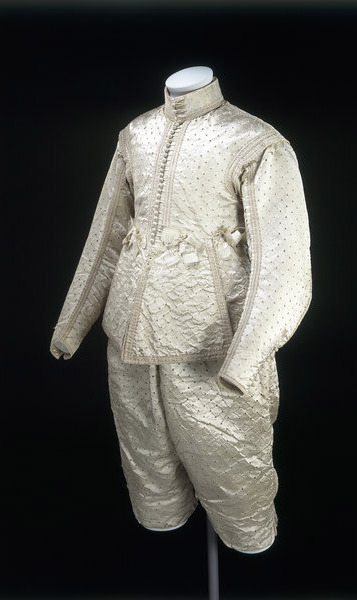
Source here
1630-40 English doublet. The collar looks mighty similar to 1930s Chinese women’s ones. I know next to nothing about Renaissance fashion so I’m not sure how it’s constructed, but it proves the point that collars like these were not a uniquely Chinese phenomenon.
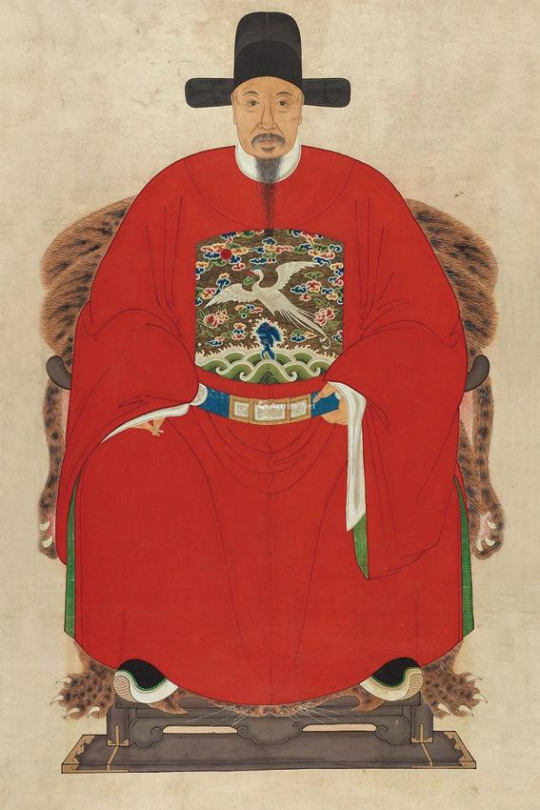
Source here
Meanwhile the Mandarins in China. He’s wearing a crossover collar robe underneath a round collar robe, no standing collar here.
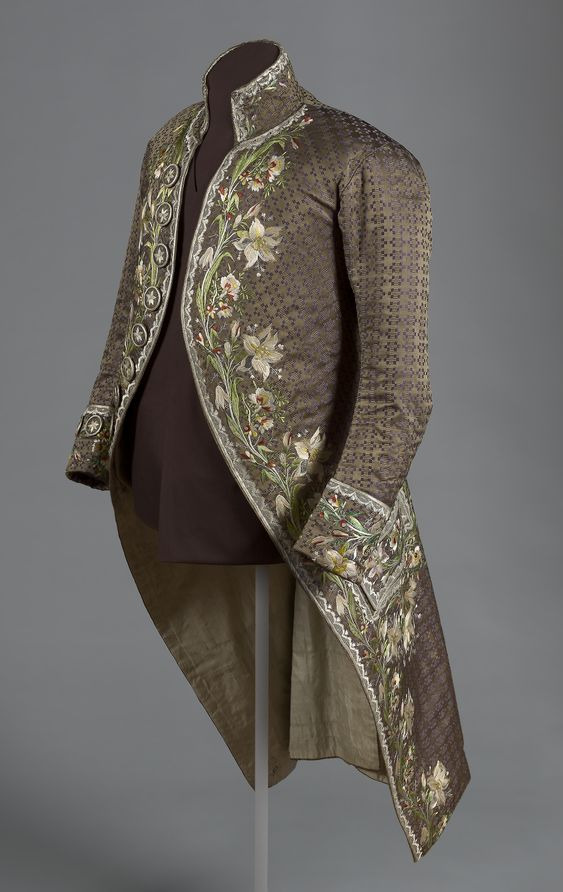
Source here
1780s French men’s coat with a standing collar.
Standing collars were also commonly used in Victorian and Edwardian women’s everyday fashion without any connection to China whatsoever.

Source here
1860s fashion plate for a gown with a low standing shirt collar peeking underneath.

Source here
1887 fashion plate from the Journal des Demoiselles. Bustle gowns with standing collars.
Bonus rant
I have come to the actual point of this series of posts, to answer the question: should “Mandarin collar” be a thing? In which case I’m gonna have to go with no. In the three posts I made on the topic I categorized a total of 13 collar styles, each distinct from each other and some being inspired by Western clothing, and showed that the use of the term “Mandarin collar” nowadays is very vague and ambiguous. I don’t understand why people in the fashion industry give my ancestors all the credits for a design feature as basic and common as a standing collar... Maybe it’s a marketing gimmick like how Sternhalma (a German board game) is advertised in the US as “Chinese checkers”?? Or maybe it shows that a lot of fashion designers lack a basic understanding of historical fashion? Either way it makes no sense. I think the concept is also slightly offensive since it simply ignores the diversity of actual historical Chinese standing collar designs, kind of reinforcing the racist stereotype that non-white fashion histories are static and never changing.
If I do have to pick a most traditional/iconic style of Chinese standing collar, I would go with either the original Ming Dynasty soft collar with metal buttons or the 1940s short collar with collar seam binding used on aoku, cheongsam, changshan and magua. In the mainland Chinese countryside, the 1940s style collar was preserved and actually still made today, but in the post-Mao era it became increasingly seen by the mainland population as 土 (a derogatory term for Chinese folk stuff meaning tacky or cringy) compared to the exciting new Western fashions being imported at the time. As a result, more traditional items of clothing like aoku for women, changshan and magua for men were neglected in favor of more westernized cheongsam designs, leading to some cursed contraptions.
Maybe this is a hot take, I personally really don’t vibe with the concept of 土 because it’s very loaded and usually the gateway drug to massive internalized racism. I’ve heard so many people bash aoku and magua constructed in the historical method and put post-60s Western inspired cheongsam on a pedestal even though the former is grounded in history and the latter is an Orientalist mess. There is nothing wrong with making aoqun, aoku, magua, changshan, cheongsam or any other historical item of clothing in the historically accurate method, they’re charming in their own ways and don’t need to be “modified”. In my opinion, the puckering under the armpits caused by the lack of a shoulder seam and the rounded shoulders are what makes historical Chinese clothing beautiful to begin with :3 I think there’s something inherently modern and authentic in the pedantic, antiquarian pursuit of historical clothing, like you know how whenever a revival happens it actually brings something new to the table? It’s not problematic to wear modern cheongsam designs per se, it’s just important to keep in mind that it doesn’t have much to do with actual Chinese history and represents more of the status quo of Chinese fashion nowadays.
Ok I’m going off the collar track but it’s time to finish this post. Thank you for reading, and as I mentioned, the next post will be about Chinese pankou. I’m almost finished with that one as well and I’m really excited with what I have planned next :D
195 notes
·
View notes
Text
Yoruichi, Kūkaku, Kisuke and the Soul Society Arc
The relationship between Yoruichi, Kūkaku, and Kisuke isn’t explored much at all in canon, despite the fact we’re expected to take away that they’re friends (if not best friends). However, I think this relationship explains a lot of what happens within the early Soul Society arc. We know from chapter 175 that:
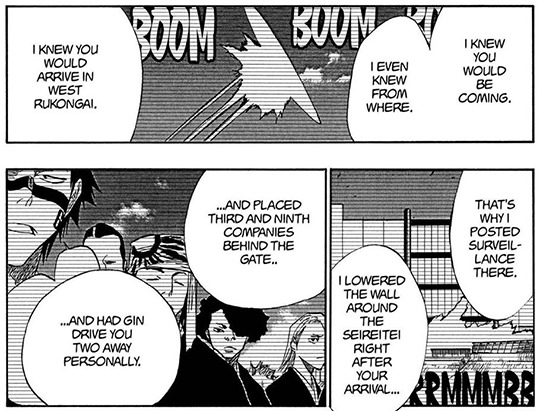

Aizen states he knew the Ryoka would be coming from West Rukongai. Why? Well, the only reasonable answer is Kūkaku. While it seems extremely evident that Yoruichi can enter Soul Society undetected in her cat form, using the Senkaimon, and has done so to remodel the Study Chamber’s annex, her going back and forth constantly is likely undesirable, and also probably didn’t happen, as chapter 78 indicates:
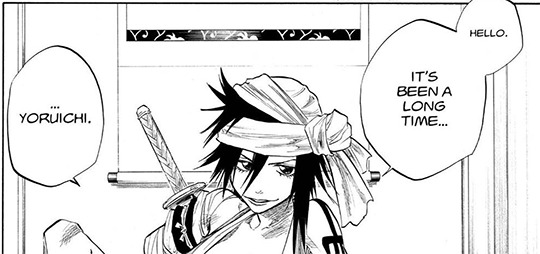
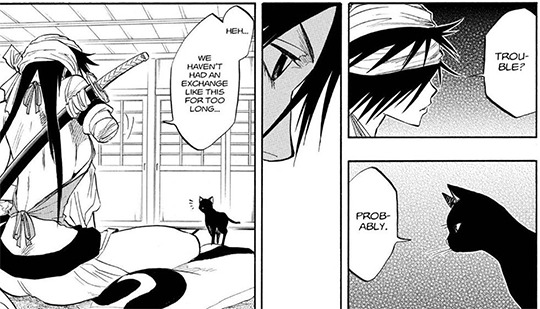
Kūkaku’s repeated emphasis of it having been a long time since she and Yoruichi have met suggests they haven’t done so since she went into exile. This is corroborated by the implication that Yoruichi does not know Ganju:
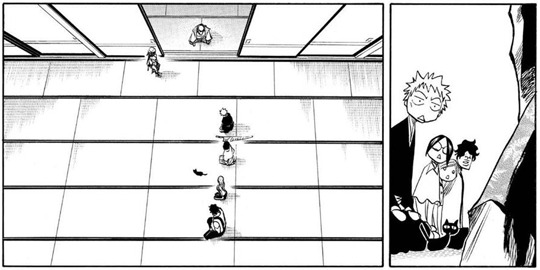
Her reaction to him introducing himself is the same as everyone else’s. You might say this is just a comedy moment, but think about it. How many people are there in Rukongai named Ganju? How many of them know some kind of strange earth magic? Yoruichi did not attach any importance to Ganju’s appearance in chapter 76 and 77, regarding him as a waste of time... when she’d literally just determined to find Kūkaku. If she knew Ganju was a Shiba and they already wanted to find Kūkaku, the sensible thing would’ve been to demand Ganju take them to her, not wander around using a map the next day. We also know from chapter 83 that:

Ganju was just a child when Kaien died, which happened sometime after 1952. (We know Hisana died “50 years ago” in 1951, Byakuya found Rukia the next year and brought her into the Gotei 13, and Rukia presumably spent at least a few years with Kaien.) This makes it likely (though by no means guaranteed, given the example of Nanao, but Ganju describes himself as “just a child” which Nanao likely wouldn’t have) that he was born after Yoruichi’s departure in 1901. They are likely to have never met before. (This also implies that Kaien, Kūkaku, and Ganju’s parents were alive until very recently, or may still be!)
So we can say 1. Yoruichi has been back to Soul Society and set up the the Study Chamber as a supply depot, and 2. she has likely not interacted with Kūkaku since leaving initially. Why the second? Well, pretty obviously, because meeting with Kūkaku would put her at risk and make things rather obvious. So, what does this have to do with Aizen? Well, that touches on another mystery: how does Kisuke get products from Soul Society?
We know from chapter 70 that Kisuke cannot go through his own Senkaimon. It follows that the same is true of Tessai. We know Yoruichi can as a cat, but likely can’t in her proper form. (Since she also comes back from Soul Society as a cat too, which is her last canonical use of the form.) We also know Kisuke’s Senkaimon can only stay open for four minutes:
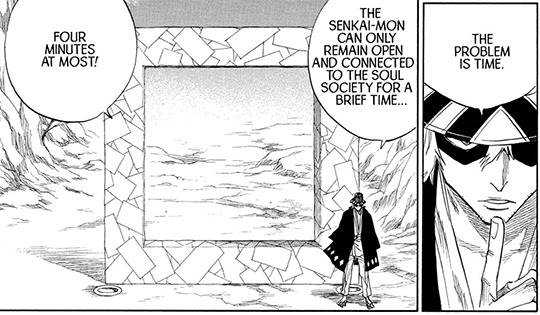
We also know that transit through the Senkaimon is perilous. So, does it make much sense that Yoruichi run through the Dangai as a cat, hauling potentially heavy cargo which might get snared in the restrictive current and lost? Nope, especially when it’s likely that Yoruichi is not often at the Shōten (as Ururu and Jinta don’t know her and they’ve likely grown like normal humans). So what is the solution then?
Kisuke opens his Senkaimon above Kūkaku’s Flower Crane Cannon and she fires cargo shells through it containing his required items. Aizen noticed this and deduced how they were operating.
Kisuke’s Senkaimon opens in the air for some reason, almost as though to accommodate the height of the cannon:
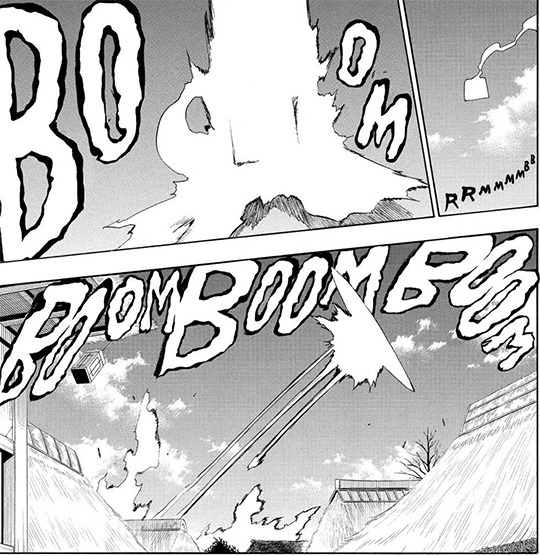
Kūkaku launches crew with Method Two and the jolt isn’t so bad. (What’s Method One for then?)

The projectiles can also make sharp turns and accelerate after launch with no visible propulsion:

So, this presents a very obvious method of safely and securely getting cargo through the Dangai without risk to anyone. It is, however, conspicuous, and it also requires a method of communication.
Kūkaku moves around a lot, but appears to stick to West Rukongai. There may be some association between the Shiba and West Rukongai (as CFYOW tells us the Shiba lived in Rukongai even when they were a Great Noble Clan) which results in Kūkaku having an association with Jidanbō, which lets her easily enter the Seireitei even when she shouldn’t be able to (per CFYOW), or maybe she stays in West Rukongai for easy access to the Seireitei through him. Maybe both.
(We never hear what Yoruichi’s original plan for infiltrating the Seireitei was, but it appears to not have involved Kūkaku. My personal bet is that the canals under the Seireitei that 4th Division use empty out somewhere, as the water has to go someplace, and Hanatarō is wrong that only 4th Division knows them: it would make perfect sense that the Onmitsukidō know them too. But that’s a different piece of meta.)
It’s also very evident that Ichigo’s use of the Spirit Core in chapter 81 is what tips off Aizen that they’re coming. His use of it is extremely obvious, with Kūkaku noticing his reiatsu from the surface:

This flare is probably similar in output to the one he emits in chapter 116, which Jūshirō says could “only belong to a Captain”, making it likely readily obvious to Aizen’s surveillance (and Kūkaku also seems very surprised at the magnitude of it). Right after Ichigo stops using the Spirit Core, an intruder alert interrupts the meeting Yamamoto is holding to discuss Gin’s punishment, and all the Shinigami are kept up all night patrolling even though the Ryoka will not actually arrive until the next morning. This was very clearly orchestrated by Aizen, from within Central 46, in order to tire out and agitate the Gotei 13 so the Ryoka would be more successful at evading capture.
(This also means that the Aizen who attended the meeting, who Tōshirō saw exchange words with Gin, was not actually Aizen. That Aizen notably sweatdrops beforehand and behaves rather weirdly during the meeting and alert. It’s Substitute-san, nervous that the show’s started, delivering rehearsed lines with Gin. Probably a different guy than the one in TBTP since this once is much better at acting. Whatever happened to him anyway?)
In other words, Aizen observed that Kisuke’s Senkaimon only operated in West Rukongai (although his assertion that it only can operate there seems to be conjecture) and posted surveillance which detected Ichigo’s reiatsu emission, thus cluing him into the Ryoka preparing to move, just as he said.
That this pattern had long ago been made was probably predictable from Kisuke’s end, and he likely deliberately played into it to encourage Aizen’s arrogance, leaving Yoruichi to improvise on the ground.
As for how Yoruichi or Kisuke could communicate with Kūkaku during this time so as to place orders for equipment without visiting her, that’s a little more complicated. It’s obviously impossible to establish a hardline connection, and any kind of emitted signaling could be intercepted. Kisuke can’t run messages through his Senkaimon without sending someone on a perilous journey or building his own launching device. But there is an easy, expedient, covert, and disposable system: couriers.
There are plenty of souls left wandering around by Shinigami on Earth: you simply give them an encoded message and tell them to find Kūkaku once they arrive in Rukongai. While where they’re sent is random, if you do this a fair number of times, one of them should be able to make it to her. (Their reward is that given she always seems to live near the Seireitei, they wind up in a pretty safe district.) As for how Kūkaku would decode such a message, a cipher could’ve been left by Yoruichi as a dead drop during one of her rare visits.
If you wanted a darker but more “express” option, you would find someone fairly tough and violent (say, Yakuza enforcers), use a memory replacer to give them a memory of the message (it seems likely that Kisuke has iterated on the standard Gotei 13 Kikanshinki, given Yoruichi mentions a Kikanshinki Deluxe in CFYOW), and then kill them and give them soul burial. Such individuals would be far more likely to survive making it to Kūkaku regardless of where they were sent. (Depending on what they were guilty of, you could encode that into the message too and let her deal with them as she might.)
Anyway, I think it’s very obvious that Kūkaku is Yoruichi and Kisuke’s main point of contact in Soul Society. Jūshirō may also be involved, given his interest in Earth (vis-à-vis Ginjō and the Fullbringers) and how unlikely it is that nobody in the 13th Division ever noticed Kisuke, an infamous criminal (both Isshin and Ikkaku immediately recognized his name), was operating openly in Karakura. Indeed, Jūshirō may be directly involved. When the Ryoka are coming down over the Seireitei, we see that it has a radial design:
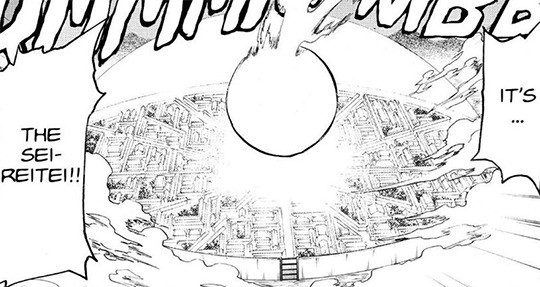
The four gates create four quadrants, each of which is divided into three. This makes for twelve slices. We know 1st Division occupies the center, so the most obvious orientation for the divisions’ physical territory is that each is simply a slice. If that’s the case, it is entirely possible that 13th Division is one of the two slices along the road coming from the West Gate, which would make it very easy for Kūkaku or her retainers to reach the Study Chamber at Sōkyoku Hill, gather supplies, and leave, or to augment them directly from 13th Division’s stocks.
24 notes
·
View notes
Text
Black Veil Brides VIP Meet and Greets
I just wanted to make a quick post since I've seen a lot of people talking about the VIP/meet and greet tickets for the rescheduled ITM/BVB tour. I know there have been some strong opinions on the COVID restrictions and questions about what will or won't be allowed.
Disclaimer: I'm not affiliated with the band or management and don't speak for them. This is just my opinion/trying to share some helpful tips and information. I’ll give references for what I say, but please take specific questions to the email listed on their website [email protected]
I’ve seen some people criticizing the band for the COVID restrictions in place as if it is solely their decision as to what will be allowed and not allowed. More than likely it was a decision made by management, the team putting on the tour, venues, etc, and made to fit state health guidelines and CDC recommendations. The idea that they will be able to have meet and greets the way they were done prior to 2020 with no restrictions is unrealistic. While COVID cases are declining and around 50% of the United State’s population has been vaccinated the pandemic is not over. There may be another rise in cases this fall and with the tour taking place during flu season it will be hard to tell who is sick with COVID or just the flu/cold. All rules and regulations for both VIP and the shows are done for the safety of the artists AND the fans. Remember that it’s not just because you could get the band sick, they could potentially get you sick too. Therefore care must be taken to make the VIP M&Gs a safe but still fun experience for both parties.
Local venues are all going to have different protocols as to what is and isn’t allowed. This is due to states having different rules as far as distancing, masking, and sanitation regulations. This is completely out of the band’s control and they are obligated to follow the rules for the venue and state they are in. The VIP ticket upgrade is OPTIONAL, you are under no obligation to purchase VIP tickets if you feel it’s not worth the price. You can purchase just the regular ticket to see the show (this is also required for VIP tickets as that ticket ONLY is for the meet and greet). I get that people are upset about the limitations, but I for one, am grateful they’re even offering VIP tickets. They could just as easily have said no meet and greets at all.
Isn’t the band vaccinated? Andy and CC have both said publicly they are vaccinated. Andy's dad has stated the band is fully vaccinated. I’m sure others are as well, along with the crew and the other bands but that doesn’t mean it’s okay to not have safety guidelines in place. Remember, that there is still a question as to whether or not someone who has been vaccinated can harbor the virus and pass it on even though they are unlikely to become ill themselves. It seems that vaccines DO provide good protection against infecting others and becoming ill but none of the vaccinates are 100% effective. The band will be traveling all over the country meeting lots of people each night, therefore obviously precautions are going to be taken to reduce the risk for everyone.
What if I’m vaccinated? That’s wonderful! I would strongly encourage everyone to get their vaccines, especially before attending a concert. Because there’s no way to really check vaccination statuses (unfortunately fake vaccine cards are way too common and easy to make) the rules have to be made with the assumption that some people there WILL be unvaccinated. Theoretically, yes, it would be safe for a vaccinated person to be without a mask on with the band if they are also all vaccinated. Since again, that can’t be guaranteed (and because that would involve different treatment for different people) the best option is to just have rules that EVERYONE will have to follow. There are also variations in the vaccine's effectiveness. Pfizer/Moderna are both 90%+ effective while J&J (one-shot) is about 65-70%.
Hugs? These aren’t allowed at BVB M&Gs anyways, even before COVID. Their websites specifically states hugs will NOT be allowed. Please respect this rule.
Gifts? Andy’s dad (Chris Biersack) spoke about this on Twitter yesterday in response to some fan questions. He says he would discourage fans from bringing gifts. I know a lot of people like to bring them gifts but the best thing you can do is come to the show and sing along and show your love for the band by supporting them. Physical gifts can wait for now, and I think everyone should respect that. Besides, space is limited on tour anyways and when you think about how many people bring them gifts each night, logistically that is hard to accommodate. I do not see anything specifically about gifts on their website so that may be something you would want to email the VIP company about or ask in the BVB Facebook group if you're dead set on bringing something. However, the website DOES state that no "personal autographs" will be permitted, only the poster they are providing.
Photos? The rules on their website state that photos will be taken with 3 feet distance between the fan and the band. Fans may take their masks OFF for the photo, but masks will be required for the M&G and while in line for it (but you get a cool BVB mask!!!!). I know people are upset over this one too but think of all the cool ways you could do this photo. You can stand in front with the band behind you and strike a pose with yourself as the centerpiece! Three feet isn’t that far either, and honestly, that’s about how much room you’d give someone for personal space anyways.
It's so expensive!!: It's the same price as their M&Gs always have been. Yes, $100 is a lot of money for most people but it's the norm for band M&Gs. I am okay with paying that price even with the COVID restrictions because I want to be able to support the band. They haven't been able to tour in over a year and I'm sure that has cost them a lot of revenue. So I have no problem paying to see my favorite band.
TIPS
Read the rules BEFORE buying tickets for the M&G or show. Call the venue to ask for specifics if you want to or check their websites. Make sure you’re okay with the rules and if you purchase a M&G then follow all rules regarding safety and distancing.
Wear a mask/the one they give you during your M&G, please respect your health and the band’s.
While vaccinated individuals according to the CDC are at lower risk while attending concerts, unvaccinated people are still at a high risk of contracting COVID. It’s a very good idea to make sure you are TWO WEEKS out from your LAST shot before your concert date.
Monitor yourself for symptoms, and if you are at ALL feeling sick, coughing, have a fever, vomiting, etc. do NOT come to the show. Missing the show sucks, but you don’t want to run the risk of infecting others.
Personally, I plan to wear my mask while inside the venue even though I am fully vaccinated. If the venue is not requiring masks to be worn inside it is up to individuals to choose to or not but I know I will feel safer with a mask on.
Give people space while in the crowd. Now isn’t the time to be right on top of someone trying to push to the front. Please respect everyone’s personal space and remember that there may be people who are at an increased risk of severe COVID infection present.
If you are in a “high risk” group, talk to your doctor about whether or not it is safe for you to attend an indoor concert.
If you are bringing your vaccination card, get it laminated first or take a photo of it and keep it on your phone. They’re paper and you wouldn’t want it to fall apart because it got wet.
Bring extra disposable masks in case yours gets wet, dirty, or something happens to it.
Wash your hands!!!!!!!!
Don’t share water/drinks/food. I know “pass the water bottle” is popular at shows but let’s skip that for now.
I think it’s important that people keep perspective on this. The world just shut down for over a year and NO concerts took place. The fact that concerts will happen this year at all is a miracle. COVID is a fluid situation and there is no guarantee that things will be better or worse when the tour starts this Fall. This is a virus that has killed millions of people worldwide and hundreds of thousands in the United States. It’s not to be taken lightly, there are serious long-term consequences for some who get COVID. Guidelines are in place for a reason and the band, venues, and management should NOT be criticized for keeping everyone safe. If you don’t like the rules then don’t buy VIP tickets or don’t go to the show, it’s that simple. Following the rules and listening to guidelines is incredibly important. Doing everything you can to ensure your safety, other fan’s safety and the band/crew’s safety should be a top priority. One day there will be “normal” concerts and M&Gs again but for now, we have to still be mindful.
Respect the rules
Respect the health and safety of yourself and others
Have fun and celebrate live music again!
#black veil brides#bvb#andy biersack#andy black#jinxx#christian coma#jake pitts#lonny eagleton#ITM#in this moment#the inbetween tour#concerts#COVID
16 notes
·
View notes
Text
It was May, 2012. Inside a gloomy, oak panelled courtroom in the Royal Courts of Justice in London, a group of bewigged British and Malaysian lawyers confronted a legal team from the British Foreign and Commonwealth office in front of a panel of judges. Led by John Halford of the Bindmans law firm and Dato Quek Ngee Meng, the legal team was in court to argue the case for a public enquiry into what they called “a grotesque, on-going injustice” committed decades earlier in British Malaya. This was the period of the ‘Emergency’: a war without a name fought in the Malayan jungles against communist insurgents who wanted an immediate end to British rule.
On the other side of the court sat lawyers for the defendants, the British Foreign and Commonwealth Office. In that rather claustrophobic courtroom, British justice was being asked to make a judgement about history and moral responsibility.
For me as an historian and journalist, it was a highly charged moment. As they spoke, the words of the lawyers seemed to evoke the restless spirits of 24 Chinese workers shot dead in December, 1948 by British soldiers on a plantation close to the Malayan village of Batang Kali.
Just one man was left alive. His name was Chong Hong and he was in his 20s at the time. He had fainted in terror and the British soldiers left him for dead. By 2012, Chong Hong was long dead. But a handful of eye-witnesses remained alive. Loh Ah Choy, just seven when the soldiers rampaged through the plantation; Tham Yong, aged 17. In Court 3 that day in 2012, three of the villagers – now in their late 60s and 70s, who had long ago watched the slaughter of their menfolk – sat apprehensive and rather frail beside their lawyers. I talked briefly to Loh Ah Choy during a break in court proceedings. After so many years, there was still pain in her eyes as she talked about the men who had died.
The ‘Batang Kali massacre’ has sometimes – and not entirely accurately – been called ‘Britain’s My Lai’: referring to a Vietnam War atrocity when ‘Charlie Company’, led by Lt. William Calley, murdered hundreds of unarmed civilians on March 16th, 1968.
Since the killings, successive British governments refused to hold a public enquiry into what had taken place and why the men were killed. At the time, it was claimed that the victims were ‘bandits’. This was baseless. No apology was, it seems, considered by the British. For decades, the relatives of the dead men like Tham Yong and Loh Ah Choy kept their silence. They had been left destitute after the killings – and survival had more meaning to them than a search for justice.
In the end, the legal case failed. The lawyers’ arguments were rejected by the UK Supreme Court in 2015 – but for the British establishment, the Court’s judgement made uncomfortable reading. For Lord Kerr, one of the court’s justices said the “overwhelming preponderance of currently available evidence” showed “wholly innocent men were mercilessly murdered and the failure of the authorities of this state to conduct an effective inquiry into their deaths.” The problem for the Court was time. The killings may have been unlawful, Lord Neuberger concluded, but they occurred more than 10 years before the critical date when the right of petition to the Strasbourg court of human rights was recognised by the UK and created a duty to investigate.
The lawyers generated a great deal of new historically valuable information – not only about what happened in Batang Kali, but about how and why a ‘very British cover up’ was maintained for so long.It was thanks to the efforts of the legal teams that we now know what happened on that day in British Malaya. There is now no dispute that on December 11th, 1948 a 14-man patrol from the 7th Platoon, G Company, 2nd Battalion Scots Guards, led by two lance-sergeants, Charles Douglas and Thomas Hughes, entered Batang Kali where they encountered 50 or so unarmed villagers.
The tiny settlement was part of the Sungei Remok rubber estate in the state of Selangor, which at the time was a British protectorate. By the time the platoon left the village the following day, 24 men had been shot dead. The first report of the killings in the Singapore-based Straits Times sounded a shrill note of triumph: ‘Police, Bandits kill 28 [sic] bandits in day … Biggest Success for Forces since Emergency Started’. It would not take long for the official story to unravel. ‘Good news’ like the Batang Kali operation was in short supply at the end of the first year of the Emergency. The roots of the conflict go back to the Japanese occupation of Malaya and Singapore, which began in February 1942. The traumatic loss of Singapore to a grossly underrated Asian foe shamed and humiliated the British and led many Asians to reassess their former masters.
In the first months of the occupation the Japanese slaughtered many thousands of Chinese civilians in Singapore and across Malaya. Japan had been waging a brutal war in mainland China since 1937 and alleged that the Chinese in Malaya were a security risk. Many young Chinese fled into the dense Malayan jungle, where they began to organise guerrilla units to fight back against the Japanese. The Malayan People’s Anti-Japanese Army (MPAJA) was dominated by the Malayan Communist Party (MCP) and by the end of the war was backed by the British ‘Force 136’, a branch of the Special Operations Executive. After the Japanese surrender in 1945 the British honoured the MPAJA , awarding its future leader Chin Peng an OBE.
As India moved towards independence the chronically indebted postwar British government clung onto Malaya, with its valuable tin and rubber resources. Although the returning colonial power signalled that independence was on the agenda, it seemed to both a new generation of Malay nationalists and the Communists that it was ‘colonial business as usual’.
This was intolerable. The MPAJA now became the vanguard of anti-British resistance, as the Malayan National Liberation Army (MNLA), turning their British-supplied guns on the returned colonial authorities. The MNLA was backed by a secret army of supporters known as the Min Yuen (People’s Movement). MNLA fighters depended on the Min Yuen and Chinese villagers, willing or unwilling, for essential supplies. This was the background to the events that unfolded in December 1948. It explains why, to begin with, the British could claim that shooting Chinese civilians on a rubber plantation was a ‘success’: in the eyes of British troops, any Chinese-Malayan villager might be a ‘bandit’ – and so ‘fair game’.
The ‘successful operation’ story crumbled rapidly. A few of the surviving villagers told their story to Li Chen, the Chinese consul-general, who held a press conference on December 21st. The following day the British owner of the Sungei Remok Estate, Thomas Menzies, who had serious clout in the British estate-owners’ community and was dismayed by the loss of 24 workers, publicly stated that his men had a long record of good conduct. By December 24th the Straits Times was calling for a public enquiry.
At the end of January the British Communist MP Philip Piratin demanded that Arthur Creech-Jones, the colonial secretary, explain the actions of the Scots Guards. Creech-Jones replied that an “enquiry by the civil authorities” had concluded that “had the security forces not opened fire, the suspect Chinese would have made good an escape, which had obviously been pre-arranged”. Creech-Jones’ ‘enquiry’ into a “necessary but nasty operation” quashed the debate about the killing.
But then there was an unexpected turn of events. In December 1969, a former National Serviceman called William Cootes confessed his role in the killings to a journalist from the People, then a British Sunday newspaper. Cootes said he was motivated by the furore unleashed by US journalist Seymour Hersh’s revelations about the My Lai massacre the previous year. The scandal provoked a debate about whether British troops would have been capable of committing such an atrocity. Public opinion resisted such slurs, but Cootes knew better. He had been one of the 14 Scots Guardsmen who had entered Batang Kali.
Cootes claimed that his commanding officer, George Ramsay, had briefed his men that they were going to a village and would “wipe out anybody they found there.” Other former members of the platoon also came forward and backed up Cootes’ allegations. Alan Tuppen testified that: “He [Ramsay] said we were to go out on patrol and that our objective would be to wipe out a particular village and everyone in it because, he said, they were either terrorists themselves or were helping terrorists in that area.”
Tuppen provided shocking new detail about the killings: “Instinctively, we started firing … at the villagers in front of us. The villagers began to fall. One man with bullets in him kept crawling … He was finally killed when a bullet went through his head.” Yet another former guardsman, Victor Remedios, testified that after the platoon returned to base “we were told by a sergeant that if anyone said anything we could get 14 or 15 years in prison.” No one had been shot trying to escape.
In the aftermath of the People story and the media storm that had followed on February 13th, 1970 Denis Healey, the secretary of state for defence, referred the matter to the director of public prosecutions (DPP). At the end of the month, DPP lawyers recommended further enquiries to be conducted by the Metropolitan Police – much to the dismay, as we learnt in court, of the Foreign Office.
All the former members of the Scots Guards platoon who had testified to the People were interviewed again under caution. Plans were made for the British police team to fly to Kuala Lumpur to continue with their enquiries. Then on June 18th, 1970 the Labour government was ousted by the Conservatives – and just weeks later the Batang Kali enquiry was stopped with a view “to uphold the good name of the army.”
The long battle for a public enquiry after determined efforts by the survivors’ legal team collapsed. This legal battle is unlikely to be joined again. Nevertheless, the UK Supreme Court was minded that the killings were unlawful and that “wholly innocent men were mercilessly murdered”. There was another disappointment for historians. When the UK National Archives announced a release of secret colonial papers in 2012, many of us rushed to Kew hoping that some of the reports made just after the killings had survived. There was bad news: it turned out that when the British pulled out of Malaya in 1957, any incriminating evidence about the events of December, 1948 had been destroyed.
For historians of the British Empire and the traumatic process of decolonisation that followed the Second World War, the discovery of new information about the tragedy that unfolded in Batang Kali casts new light on the longest war fought by British troops in the 20th Century, the Malayan Emergency – and the counter- insurgency techniques developed in Southeast Asia that influenced American strategy in Vietnam and impact bitterly contested campaigns in Iraq and Afghanistan today.
16 notes
·
View notes
Note
hey, can you tell us a bit about racism in Spain? I'm incredibly uneducated about it, and I don't know much about Spanish history especially racism wise so it would be really nice to get an insight from you about it.
this is a big question, since Spain’s relationship with xenophobia dates back centuries and I’m neither the most qualified person to take you through it nor someone who has suffered from Spanish society’s racist tendencies. However I’ll try to piece a bit of something together and maybe other people can add on if there’s other stuff to include. Also, this is mainly Spanish history from a racism perspective, there are many other positive things in other areas that I haven’t included (patriota pero no mucho)
So basically, up until the 15th century, Spain (in its then form) was a relatively harmonious melting pot of different cultures. With the Roman invasion, settlements and a Visigoth takeover (Germanic population) thereafter, Christianity was pretty firmly established in the country/iberian peninsula by the 2nd Century AD. In 711 AD the Moors, who had control over Islamic Africa, invaded the peninsula and established a Caliphate named Al-Andalus which had a particular stronghold in the south: in Andalusia and their Córdoban capital. Rule was stronger or weaker depending on the region but largely Islamic rule was established and Jewish and Catholic people were treated as second class citizens. Córdoba became the wealthiest, largest and most sophisticated city in Europe by the end of the tenth century, with trade and rich intellectual North African traditions forming a unique culture in the region.
There is a strong historical basis that during a lot of this period there was pockets of ‘La Convivencia’ ie. the co-existence of Jews, Christians, and Muslims. Like for example, around Toledo where in universities the three backgrounds contributed to tremendous amounts of sharing of knowledge etc.
However, from about the 9th century onwards the Catholics who still held strong points right in the north, begun ‘la Reconquista’, the “reconquest,” where they began chipping away at the Caliphate’s dominance. By the early 11th century they had gained more land than was held by the Muslims and 1492 is where we set our next scene.
This is probably one of the biggest and most path changing years in Spanish history. Most known for being the year when Columbus landed in America, this enabled the start of Spanish imperlism which would extend to almost 5 centuries afterwards, conquering territories in South America, Africa and Asia and subjecting them to imperialistic rule and policies of white totalitarian dominance.
The second important happening in this year was the fall of Granada, the last remaining territory the Caliphate had in Spain, signifying the end of Muslim rule in the country. They were, as expected, thrown out of the country in their droves and many others were forced into hiding being subject to situations that would only get worse with the Inquisition in full swing.
The third, and last, big event in this year was outlined in the Alhambra Decree where the expulsion of all practicing Jews was announced. Now this had already followed the forced conversion tens of thousands of Jews had been subjected to in 1391 and 1415 (ie. crusades and masacres against them). As a result of the Alhambra decree and the prior persecution, over 200,000 Jews converted to Catholicism and around 160,000 were expelled.
This ended religious diversity in Spain, the Inquisition sealed this fate. If you’ve heard of one thing about all of this I’m sure it’s the spanish inquisition. Primarily set up to identify heretics among those who converted from Judaism and Islam to Catholicism and ensure the establishment of the Catholic monarchy, it became a method of torture, fear and murder for those who were perceived to cause any threat to the Spanish catholic order. The effects of the Inquisition are widely debated, with some saying the death toll and magnitude has been blown up by the Protestants in other European countries at the time and does not show the full picture of the hundreds of thousands of converted jews and muslims who remained and overtime became integrated into Catholic society. Whilst others remaining firm to the devastating measure of these actions and the ‘pure blood’ mentality it created. What’s for certain though, is that by the end of the Inquisition in 1834 very little religious nor ethnic diversity remained in Spain.
Jump forward about 100 years and the Spanish Empire is no more after the 1898 crisis, there’s a weird back and forth period with Republics and Monarchies and dictatorships until the Civil War broke out in 1936. It lasted until 1939 when the Nationalists, led by Franco, took total control of the country and submitted it to a dictatorship that would last until his death in 1975. I don’t even know where to begin with a period that many people see as rosy and many others ignore completely whilst Historians have now gone so far as to call the 1940s and 50s the ‘Spanish Holocaust’. However I’ll break it down to one or two main things that have predominantly spurred on today’s racist attitudes.
During the Civil Rights movements of the 50s and 60s Spain was largely immune to the winds of changes due to their isolationist policies and dictatorial power holds. We didn’t take part in any of the dialogue nor go through any racial reconciliation, at least to much a lesser extent than most other countries. It’s quite a common thing to say that what much of europe did in 70 years we’ve only had time to do in 45, and there’s much of a grain of truth in this.
A famous conservative spanish politician called David Aznar defended these views and can be extrapolated into the sentiment that existed to facilitate the transition to democracy and still remain today: "In the democratic transition there were implicit and explicit agreements. One was that we Spaniards don't want to look to the past. Let's not disturb the graves and hurl bones at one another.” As a society, we hate to think about the past, it’s just not widely done. There’s ONE museum solely dedicated to the Civil War, the Historical Memory Law passed in 2007 to try and increase the rights of victims and their families was met by so much opposition and is devastatingly underfunded etc etc. This still translates to spaniards’ views on racism, saying it just doesn’t exist here and moving on. There’s a refusal to confront this and microagressions are ingrained in the culture.
As I’ve kind of mentioned before, issues of race extend much further than towards just black people which is why the US BLM movement cannot simply be traced onto Spain. People who are originally from Latin America face extreme stereotypes and varying forms of discrimination against them as do Arab populations and other people who have immigrated from MENA countries plus the large Roma communities.
The refugee crisis has further perpetuated the stigma around African immigrants in the past years, whilst the social effects of the 2008 Financial Crisis and beyond also continue to contribute to a xenophobic and nativist perspective where true spaniards should be prioritised with jobs, opportunities etc. For example, the alt-right wing party Vox that’s blatantly racist, anti-immigrants etc posted something with the slogan ‘Spanish Lives Matter’ the other day. They are purposefully incendiary.
Anyways, hope this was a suitable start for you, you can’t summarise millennia worths of history into a few paragraphs but I tried my best. Also there are obviously many who stand for none of these values, politicians who have tried to right these wrongs, activists who keep fighting the fight, people who have broken down barriers and areas where there’s complete coexistance. However the fact remains that these views and ideas are ingrained in people’s minds, theres blatant job discrimination and a lack of equal opportunities despite laws that may have been put in place.
I’m going to point anyone who has got this far to a couple of articles about racism from an Anglo-Saxon perspective below, racist football culture is almost always mentioned. Being a black traveller in Spain; Same Spanish Holocaust link as before but an extremely important book review read; Irish perspective on the Enigma of Spanish Racism; Racism? What Racism? Asks Spain; Opinion: Racism Is Alive and kicking in Spain
#almost a decade of ciencias sociales and cono lessons pulling through#anyways there's a lot here so maybe dont read it all by id recommend having a good skim of it!#i tried ny best to condense almost two centuries worth of histort into one post lol#blm#black lives matter#racism#spain#españa#history#og#the asks#*not two centuries lol two millennia im out here discrediting myself and everything i wrote
41 notes
·
View notes
Note
Hi! I just saw your commentary on the post regarding Hans Holbien's The Ambassadors painting. In your breakdown, you provided a picture of the Sistene Chapel's ceiling. I had never seen the full ceiling before and was curious what knowledge you may have regarding the various scenes painted. Thank you!
HOOBOY do I ever have thoughts!!
First, a quick caveat: you have to understand that the ceiling of the Sistine Chapel is huge. Like, huge huge. Five thousand square feet huge. There’s only nine (9) main frescos running down the center of the area, but there are 47 separate pieces in total—not even counting the 20 ignudi (nude youth), architectural framing, 10 medallions, or various bronze characters—adding up to very nearly three hundred and fifty individual figures.
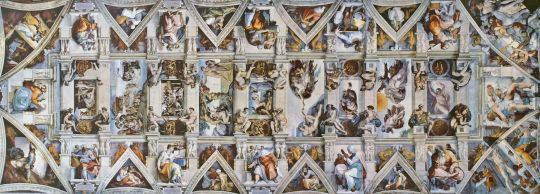
There’s a reason it took Michelangelo four years is all I’m saying.
OKAY so the ceiling can broken up into roughly four main categories:
The Nine Frescos - aligned directly down the center and meant to be read sequentially (starting when on the altar side of the room, not from the door), these depict prominent scenes from the book of Genesis. They can be grouped further into sections of three: 1-3 depict God creating the world generally, 4-6 depict the creation & fall of man, and 7-9 depict the story of Noah.
The Twelve Prophets - these squared paintings surround the center line, featuring an alternating set of five sibyls (famous historical but non biblical prophetesses) and seven Old Testament prophets. The particular individuals were chosen based on their Messianic prophecies (because even though all the images on the ceiling are from the OT, the point is still to direct the viewer to the Christ of the NT).
The Four Pendentives - triangular in shape and forming the corners of the ceiling, these showcase moments of Israel’s deliverance in the OT, with particular interest in the heroes that were popular at the time: Moses (The Brazen Serpent), Esther (The Punishment of Haman), David (David and Goliath), and Judith (Judith and Holofernes).
The Ancestors of Christ - made up of eight triangular compositions on either side of the length of the ceiling, these are located directly above the lunettes (moon-shaped compositions arched over the windows). These show various figures from the family/ancestral line of Christ.
You can see a visual breakdown in this diagram:

There are additional sections besides those four—the ten medallions (two on every other of the main frescos), which depict more (mostly violent) OT scenes; the twenty ignudi (two nude males on either side of each medallion), which are maybe angels maybe Peak Humans™ maybe who knows; and the lunettes (arched sections above the windows), which at one point portrayed all of Christ’s genealogy as found in Matthew, but two of them were covered over by Michelangelo himself in 1537 to make room for The Last Judgement, making the set incomplete.
Aight now that you have the tl;dr of the layout, you can see that it is A Lot™. Since picking even one section can easily (and has easily!) filled entire theses, I’m actually going to pull back a bit and talk more generally about form and structure, because—in large part due to his background as a sculptor—Michelangelo’s perspective and dimensionality is just masterful.
A quick reminder that the Sistine Chapel ceiling looks like this:

And, for a close-up, like this:

Obviously the figures are gorgeously done, to the point that they could be confused for sculpture rather than paintings (let it never be said that Michelangelo didn’t love himself some muscles), but what really makes me go feral is that that there ceiling?
That ceiling’s flat.
Okay not technically flat in that it’s dome-shaped, but flat in that there are no columns. The original, unpainted Chapel looked something like this:

Which, as you can see, is missing all that lovely architecture dividing up the ceiling.
The columns, structure, and forced perspective were painted, not sculpted, using a technique known as grisaille. The monochrome style was frequently used to call to mind classic Roman architecture (such as the pediment reliefs on the Pantheon and Parthenon), as the Greco Roman aesthetic was generally seen as the height (no pun intended) of artisan culture.
It’s no coincidence that Michelangelo took this route as, up until this point in his career, he wasn’t known for his painting much at all. He’d certainly made a name for himself as a sculptor through pieces like David or The Pieta, but this was to be his first major painting project—one he nearly turned down, because of the enormity of it all. The Pope, however, was quite set on it, so he eventually accepted—with a blank check to paint “whatever he liked.”
So he did—and his background in sculpture uniquely prepared him for creating more “active” bodies, such as in The Libyan Sibyl.

There’s a billion and one essays on her but for now let’s just notice the half-turned position, the musculature of her back (Michelangelo used a male model; do with that what you will), the sweeping lines of fabric, and the way her toe is just barely resting on the ground.
This is a painting that is alive: it gives off the sense that these figures are doing, rather than simply being.
Dynamics & motion were key to the composition Michelangelo wanted to create, partially because it’s that flow of motion that helps pull the viewer from one side of the ceiling, in the first fresco, all the way across the room to the last—and therefore, through the biblical narrative it portrays.

It’s so common it’s arguably kitsch to talk about The Creation of Adam (the fourth fresco), but what I want to point out is, like in the Sibyl painting, the movement of it all.
The bodies are twisted, muscles flexed and coiled; there’s a languidity to Adam’s movements as opposed to the fierce, powerful forward momentum in God’s.
Traditionally, the Christian God and other deities were shown in more staid, immobile positions, and while Michelangelo was not the first painter to break from that—that right arguably goes to Giovanni di Paolo—he was rather instrumental in shifting that paradigm, and once again, establishes this set of frescos as one interested in movement.

Finally, it would be hideously neglectful to discuss the form of the Sistine Chapel without mentioning colour, so one last thing.
As you may or may not know, art restoration is... controversial in the art world, to say the least. However, the Sistine Chapel went through a restoration beginning in 1980 and eventually completed in 1994, with the result washing away of several hundred years’ worth of grime and candle smoke, applying an awful lot of glue varnish, and touching up details/mending cracks:
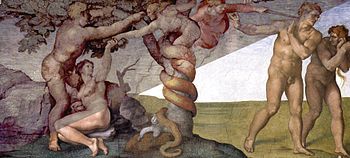
Rather drastic, no?
It sparked a rather intense debate (that has still not eased up and doubtless ever will) about whether or not the conservators removed too much of the grime (for various reasons—the conservation work assumed all the painting was done buon fresco, which meant if Michelangelo had added any touch-ups after the fact those would’ve been removed; some suggest some of the smokey look wasn’t just smoke but actually a deliberate carbon black wash, etc., etc.).
Regardless, it at least allowed for a better look at some of the dynamics Michelangelo incorporated through his shading and highlights, as well as giving his brighter colours a chance in the limelight. This new, brighter version will keep the ceiling intact for many more viewers and critics for years to come.

(...At least until the next person decides to mess with it. It’s also had restorations in 1547, 1625, 1710, and 1935, so, y’know. Wait another 50-70 years and we’ll probably give it yet another go.)
#asks#art history#classic art#sistine chapel#memrants#religion#sgtbarnes107#long post#there's literally SO MUCH to talk about here#many apologies for everything I had to leave out
39 notes
·
View notes